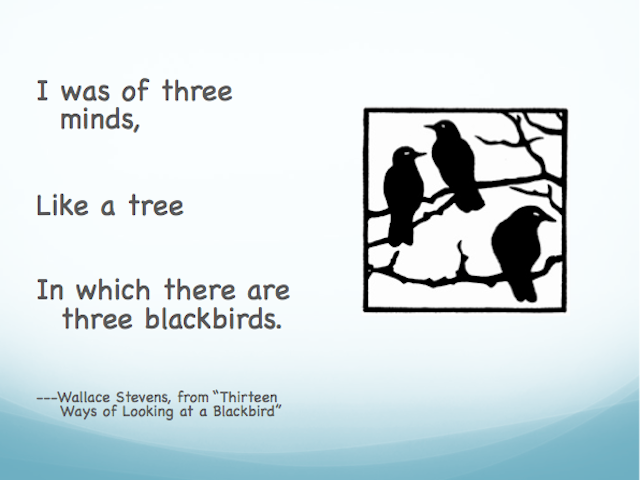Thirteen Ways of Looking at a Blackbird by Wallace Stevens

In a letter about his poem, “Thirteen Ways of Looking at a Blackbird,” Wallace Stevens writes that the poem “is not meant to be a collection of epigrams or ideas, but of sensations.”
The poem is made of up thirteen stanzas—thirteen sensations—each marked by a Roman numeral. Each stanza has the word blackbird in it.
I like the second stanza. Number II:
I was of three minds,
Like a tree
In which there are three blackbirds.
I also like the ninth. Number IX:
When the blackbird flew out of sight,
It marked the edge
Of one of many circles.
I like the way that each way of looking at a blackbird is distinct and complete unto itself.
I like the sense in the poem of worlds beyond the landscape of the poem itself—a blackbird marking the edge of one of many circles.
In his book, Writing With Power, Peter Elbow suggests a writing exercise in which one follows Wallace Stevens’ example and writes a poem “that looks at or talks about the same thing over and over again.”
Elbow writes of how he did this himself with a cherry tree—looked at it in different ways and made this discovery:
I see now that it is about missing the house on Percival Street where we used to live. . . If I had tried to write a poem about missing that house, it probably would have been terrible. Being stuck with having to write tiny stanzas about that cherry tree did it for me.
The cherry tree gave him a way in to writing what he wanted to write—perhaps to what he was longing to write.
The thirteen ways gave him a way in.
Gave him more than one way in.
I tried this exercise once with a writing workshop I was teaching to women with cancer. I told the women they could choose to write thirteen ways about anything at all and they chose to write about cancer. They wrote as a group, taking turns, the stanzas coming fast, one after the other. They actually ended up writing sixteen ways of looking at cancer. Then one of the women who had been absent came the next week and she added two more ways and they ended up with a poem, “Eighteen Ways of Looking at Cancer.”
What I noticed in that workshop when the women were writing those different ways was that knowing they were writing a lot of different ways had a freeing effect. They weren’t writing the only word on cancer—the last word on cancer. They were just writing one way of looking at cancer, and then another, and then another.
You could try it if you wanted. You could become one of the ones looking. You could write seven ways or sixteen ways or eighteen ways of looking at . . . what?
The full poem can be found here.
Elbow’s Writing with Power here.
And here is the poem the women wrote at Cancer Services: Eighteen Ways of Looking at Cancer
